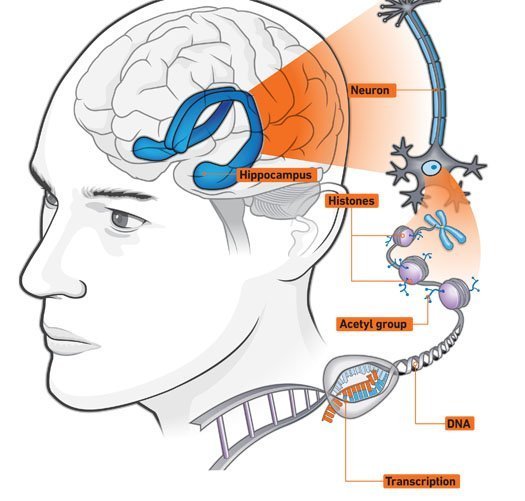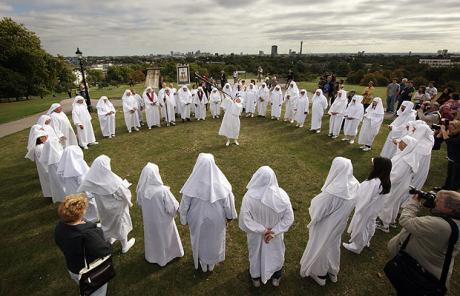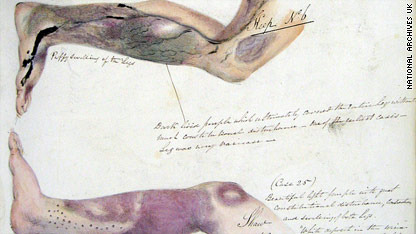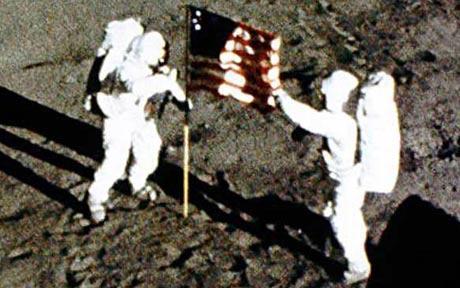Derren Brown's Blog, page 73
October 5, 2010
Instant Expert: Rebuilding Human Minds

"Age-related memory loss—the kind where you remember friends from decades ago but can't remember your grandchildren—is largely a mystery, but a class of com-pounds used to treat cancer has given neuroscientists clues to its molecular underpinnings. Scientists also suspect that the compounds responsible for this insight, called histone deacetylase inhibitors, could significantly slow memory loss—perhaps for years. (Two drugs used now to treat memory loss and Alzheimer's disease work only for a short time.) A study on aging mice by scientists at the European Neuroscience Institute in Germany published this May in Science showed that histone deacetylase inhibitors helped mice perform more than 50 percent better on a memory test than controls did. Study co-author André Fischer says these drugs would be used together with others to treat Alzheimer's patients.
HOW WE MAKE MEMORIES
The process of forming long-term memories—those that persist for more than a few dozen seconds—is poorly understood, but here's what we know: Neuroscientists have evidence that the brain's hippocampus is central to the process. To consolidate a memory, a cascade of electrical pulses fire across the gaps between neurons, called synapses. This triggers the release of neurotransmitters, which form new connections between neighboring neurons. But neurotransmitters can't be synthesized without each cell tapping into its DNA."
Read more at Pop Sci (Thanks @XxLadyClaireXx)
October 4, 2010
Gigantic Spider Webs Made of Silk Tougher Than Kevlar

"A spider discovered deep in the jungles of Madagascar spins the largest webs in the world, using silk that's tougher than any known biological substance.
Named Caerostris darwini, or Darwin's bark spider, the inch-wide arachnid's webs can cover 30-square-foot areas, hanging in midair from 80-foot-long anchor lines.
The webs' size generates enormous structural stresses, magnified by the struggles of trapped prey. Strands must "absorb massive kinetic energy before breaking," and are "10 times better than Kevlar," wrote University of Puerto Rico zoologist Igni Agnarsson in Public Library of Science One.
Agnarsson and Slovenian Academy of Sciences biologist Matjaž Kuntner discovered C. darwini in 2008. It's similar in many ways to Caerostris species found in Africa, but those spiders live at the edges of forest clearings. In Madagascar, where animals have taken kaleidoscopic forms since the island split from mainland Africa 165 million years ago, C. darwini evolved to exploit the airspace above streams and rivers."
Read more at Wired (Thanks Christopher C)
Druidry recognised as religion in Britain for first time

"The Druid Network has been given charitable status by the Charity Commission for England and Wales, the quango that decides what counts as a genuine faith as well as regulating fundraising bodies. It guarantees the modern group, set up in 2003, valuable tax breaks but also grants the ancient religion equal status to more mainstream denominations. This could mean that Druids, the priestly caste in Celtic societies across Europe, are categorised separately in official surveys of religious believers.
Supporters say the Charity Commission's move could also pave the way for other minority faiths to gain charitable status. Phil Ryder, Chair of Trustees for The Druid Network, said it had taken four years for the group to be recognised by the regulator. "It was a long and at times frustrating process, exacerbated by the fact that the Charity Commissioners had no understanding of our beliefs and practices, and examined us on every aspect of them. Their final decision document runs to 21 pages, showing the extent to which we were questioned in order to finally get the recognition we have long argued for," he said.
Emma Restall Orr, founder of The Druid Network, added: "The Charity Commission now has a much greater understanding of Pagan, animist, and polytheist religions, so other groups from these minority religions – provided they meet the financial and public benefit criteria for registration as charities – should find registering a much shorter process than the pioneering one we have been through." In its assessment of the Druid Network's application, the Charity Commission accepts that Druids worship nature, in particular the sun and the earth but also believe in the spirits of places such as mountains and rivers as well as "divine guides" such as Brighid and Bran."
Read more at The Telegraph (Thanks Tracey)
October 3, 2010
Monkeys See Selves in Mirror, Open a Barrel of Questions

"Monkeys may possess cognitive abilities once thought unique to humans, raising questions about the nature of animal awareness and our ability to measure it.
In the lab of University of Wisconsin neuroscientist Luis Populin, five rhesus macaques seem to recognize their own reflections in a mirror. Monkeys weren't supposed to do this.
"We thought these subjects didn't have this ability. The indications are that if you fail the mark test, you're not self-aware. This opens up a whole field of possibilities," Populin said.
Populin doesn't usually study monkey self-awareness. The macaques described in this study, published Sept. 29 in Public Library of Science One, were originally part of his work on attention deficit disorder. But during that experiment, study co-author Abigail Rajala noticed the monkeys using mirrors to study themselves."
Read more at Wired
Best Environmental Photos of 2010 Named

"Thousands of Munk's devil rays crowd the Sea of Cortez off Mexico's Baja California Sur state (map) in 2009. The aerial image won top honors and the "Underwater World" category in the 2010 Environmental Photographer of the Year awards.
German photographer Florian Schulz said the scope of the ray congregations was unknown until he and a pilot happened upon the gathering while searching for migrating whales.
Perhaps just as rare is the composition Schulz captured. "I was able to show how these rays are jumping out of the water," he said, "and at the same time I'm able to show—almost like an underwater photograph—how there're layers and layers and layers of rays."
The International Union for Conservation Union lists Munk's devil rays as near threatened, due in part to their vulnerability to gill nets—hard-to-see "curtains" of netting.
Given ray gatherings like the one pictured, Schulz said, "you could imagine a single net could take thousands and thousands."
This helps explain why, upon seeing the winning photo, marine ecologist Giuseppe Notarbartolo di Sciara emailed Schulz to express his delight at seeing so many Munk's devil rays thriving in a single frame. Di Sciara helped identify the species in 1987.
Organized by the London-based Chartered Institution of Water and Environmental Management, the Environmental Photographer of the Year contest honors amateur and professional photographers who "raise awareness of environmental and social issues." This year's edition drew more than 4,500 entries from photographers in 97 countries."
Read more at National Geographic (Thanks @XxLadyClaireXx)
'Space hotel' plan unveiled in Russia

"A Russian company has unveiled an ambitious plan to launch a "cosmic hotel" for wealthy space tourists. Orbital Technologies says its "comfortable" four-room guest house could be in orbit by 2016, Russia's RIA Novosti news agency reports. Guests would be ferried to the hotel on a Soyuz shuttle of the type used to transport cosmonauts to the International Space Station (ISS). The Moscow-based firm did not reveal how the hotel would be built or funded.
Up until now space tourists, such as American businessman Dennis Tito, have squeezed into the cramped ISS, alongside astronauts and their experiments. The new hotel would offer greater comforts, according to Sergei Kostenko, chief executive of Orbital Technologies. "Our planned module inside will not remind you of the ISS. A hotel should be comfortable inside, and it will be possible to look at the Earth through large portholes," he told RIA Novosti.
The hotel would be aimed at wealthy individuals and people working for private companies who want to do research in space, Mr Kostenko said. It would follow the same orbit as the International Space Station. The first module would have four cabins, designed for up to seven passengers, who would be packed into a space of 20 cubic metres (706 cubic feet). Mr Kostenko did not reveal the price of staying in the hotel. However he did say that food would be suited to individual preferences, and that organisers were thinking of employing celebrity chefs to cook the meals before they were sent into space."
Read more at BBC News (Thanks Tracey)
Life of a Navy surgeon: Rum, worms and tobacco cures

"Blood letting, tobacco smoke blown into the lungs, rum rubs and even the sight of Australia were some of the treatments used – with varying degrees of success – by surgeons of Britain's Royal Navy to treat patients from the late 1700s to the late 1800s, government records released Friday show.
Britain's National Archives has cataloged and made available to the public journals and diaries from surgeons who served on ships and in shore installations from 1793 to 1880. The archive represents "probably the most significant collection of records for the study of health and medicine at sea for the 19th century," said Bruno Pappalardo, naval records specialist at the National Archives.
Rum was the treatment of choice aboard HMS Arab during a voyage to the West Indies in 1799 and 1800. A surgeon writes that "application of rum" to the area of a scorpion or centipede bite helps prevent paralysis. The same surgeon mixed rum with oil to treat a tarantula bite.
Aboard HMS Princess Royal in 1801, tobacco was thought to have curative properties. A man who had fallen overboard and was submerged for 12 minutes was brought back aboard the Princess Royal with the appearance of a corpse, surgeon Ben Lara wrote. The victim was dried and warmed by hot water bottles and then tobacco smoke was pumped into his lungs through a tube. After almost an hour of treatment, a pulse was detected and the man lived, according to the journal.
Aboard the convict ship Albion in 1828, surgeon Thomas Logan wrote that the spirits of the convicts when they catch first sight of their destination in New South Wales, Australia, is lifted so much that "the horde of trifling cases which were used daily to assail us has disappeared. They seem to have left off getting sick, or are become indifferent about being cured!""
Read more at CNN (Thanks @XxLadyClaireXx)
October 2, 2010
The Bronnikov Method
As looked into during Derren Brown Investigates – The Man With The X-Ray Eyes, The Bronnikov method has also been investigated by EsoTV.
(Thanks Alexander)
Long-lost footage of Apollo 11 moon landing to be screened

"The video runs for a few minutes and is considered to be some of the best footage of the historic 1969 moonwalk, but the film was lost in archives for many years and was badly damaged when found, said John Sarkissian. It depicts the first few minutes of Armstrong's descent which was recorded in Australia as Nasa was still scrambling for a signal, showing a far clearer image than was initially screened worldwide.
Telescopes in remote Australia played a key role in the Apollo 11 mission, including provision of the television signal, after Armstrong decided to attempt the moonwalk early, putting the United States just beyond the horizon. A fictional account of Australia's role in the moon landing was the subject of a film in 2000 called The Dish, starring Sam Neill. Mr Sarkissian, an historian and astronomer in charge of the Australian side of the recordings restoration project, said the unseen minutes were the "best quality of Armstrong descending the ladder." "NASA were using the Goldstone (California) station signal, which had its settings wrong, but in the signals being received by the Australian stations you can actually see Armstrong." "In what people have seen before you can barely see Armstrong at all, you can see something black – that was his leg."
The segment which runs for "just a few minutes" will be screened at the awards night of Australian Geographic magazine next Wednesday, at which Apollo 11 astronaut Buzz Aldrin will be the chief guest. "When we heard Buzz was going to be the guest of honour we thought 'what a great opportunity'," Mr Sarkissian said."
Read more at The Telegraph (Thanks Tracey)
Survey: Americans don't know much about religion?
"A new survey of Americans' knowledge of religion found that atheists, agnostics, Jews and Mormons outperformed Protestants and Roman Catholics in answering questions about major religions, while many respondents could not correctly give the most basic tenets of their own faiths. Forty-five percent of Roman Catholics who participated in the study didn't know that, according to church teaching, the bread and wine used in Holy Communion is not just a symbol, but becomes the body and blood of Christ. More than half of Protestants could not identify Martin Luther as the person who inspired the Protestant Reformation. And about four in 10 Jews did not know that Maimonides, one of the greatest rabbis and intellectuals in history, was Jewish.
The survey released Tuesday by the Pew Forum on Religion & Public Life aimed to test a broad range of religious knowledge, including understanding of the Bible, core teachings of different faiths and major figures in religious history. The U.S. is one of the most religious countries in the developed world, especially compared to largely secular Western Europe, but faith leaders and educators have long lamented that Americans still know relatively little about religion.
Respondents to the survey were asked 32 questions with a range of difficulty, including whether they could name the Islamic holy book and the first book of the Bible, or say what century the Mormon religion was founded. On average, participants in the survey answered correctly overall for half of the survey questions.
Atheists and agnostics scored highest, with an average of 21 correct answers, while Jews and Mormons followed with about 20 accurate responses. Protestants overall averaged 16 correct answers, while Catholics followed with a score of about 15."
Read more at Yahoo News (Thanks Christopher C)
Derren Brown's Blog
- Derren Brown's profile
- 797 followers



